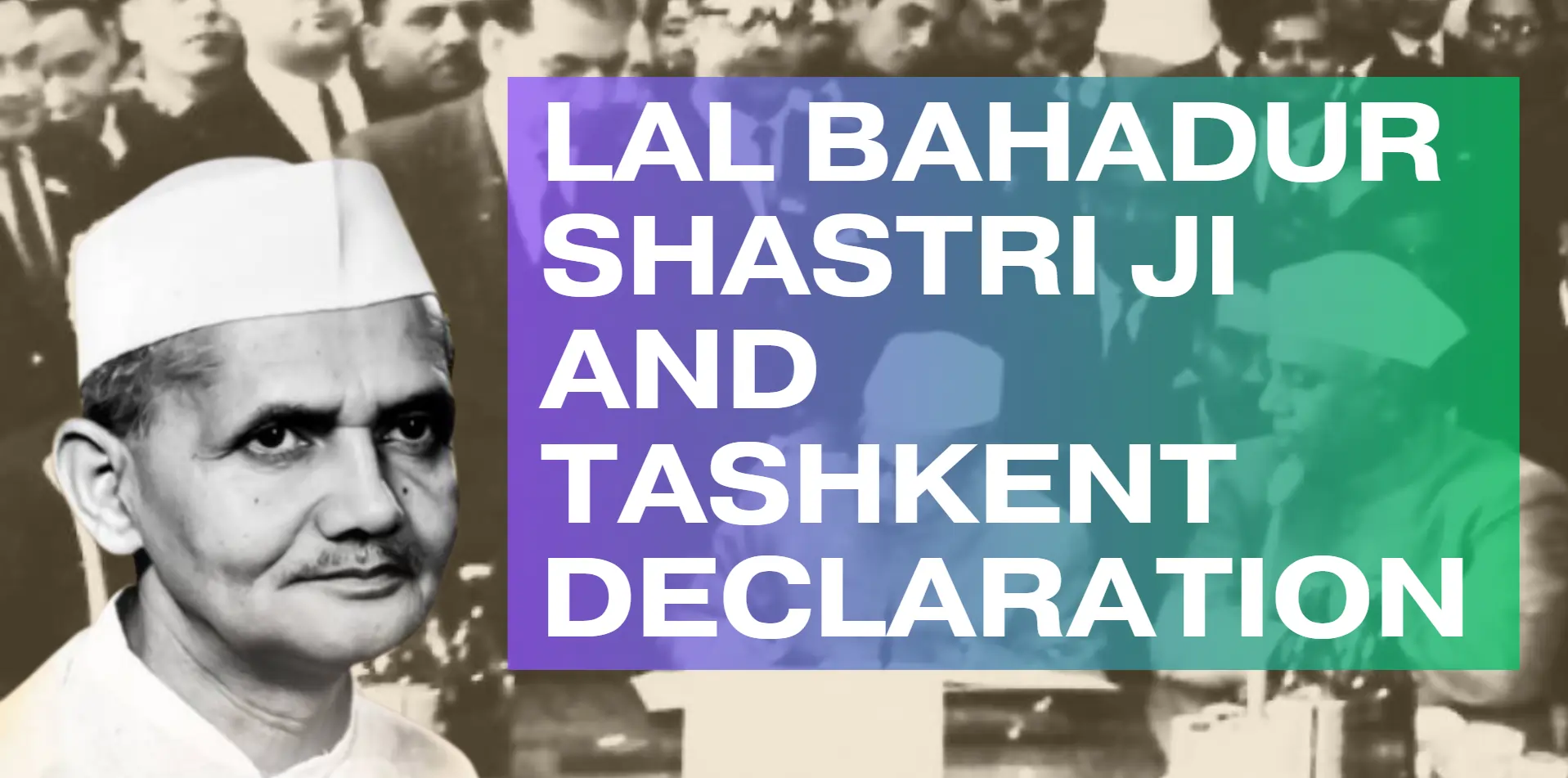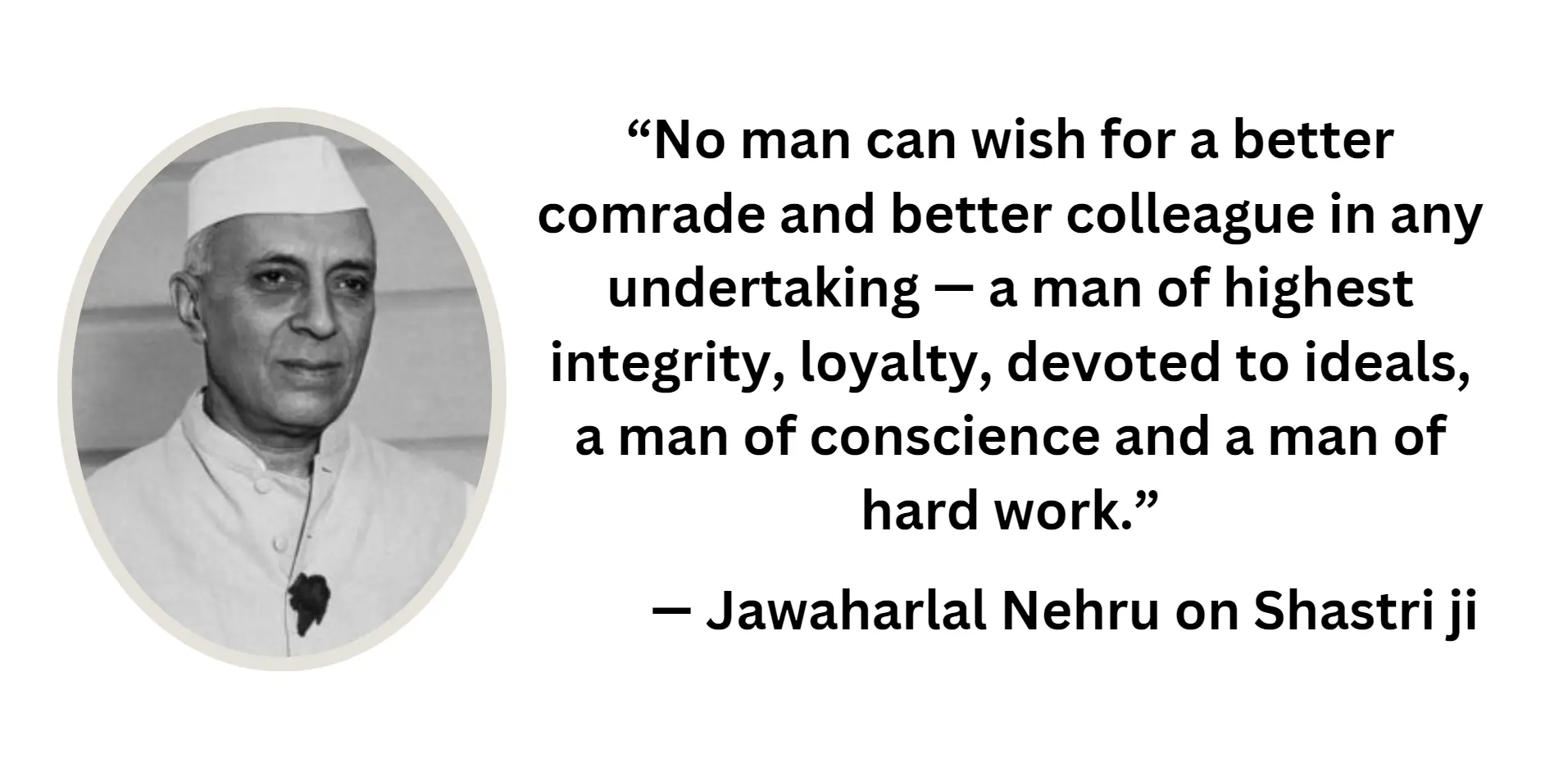
The Tashkent declaration is an important peace treaty between India and Pakistan signed on January 10th 1966, done to halt the Indo Pakistani war of 1965. These were formally signed on January 6, 1966 with the Indian Prime Minister Lal Bahadur Shastri and the Pakistani President Muhammad Ayub Khan with the Soviet Union serving as an intermediary at Tashkent, Uzbek SSR (now Uzbekistan). This treaty was intended to re-establish friendly and peaceful conditions for the two states and to develop good neighbourly relations between the peoples of the two countries.
Background of the Conflict
War in 1965 was a result of regular border tension and small scale clashes which increased in the region of Kashmir, which is under dispute between both countries. The conflict started initially in April 1965 and extended to August when Pakistan started organizing operations that would let its forces into the Kashmir region. India retaliated full scale and the two clashed till September 1965. Many of them and their armour were lost and both sides were at parity and the war was not conclusive till that time.
Principal Provisions of the Tashkent Declaration
Some of the major clauses in the negotiations were as follow:
- Withdrawal of Troops: The two shall ensure their armed forces remain opposite one another at locations they had been defend on the fifth of August in the year 1965 not later that the twenty-Fifth of February in the year 1966.
- Cease-Fire: Each country also pledged to observe the terms of the cease-fire on the cease-fire line itself.
- Non-Interference: The two did not abide in each other’s territory; there was an understanding that each of the two would not meddle with the other’s affairs.
- Restoration of Diplomatic Relations: High Commissioners of both countries would be back on their seats and there will be the continuation of business as usual in the diplomatic Corps.
- Repatriation of Prisoners of War: Such of the prisoners of war as were detained by both governments were to be returned by each government to the other.
- Promotion of Friendly Relations: To these Paramount was supposed not to engage in propaganda against the other and also encourage friendly propaganda.
- Economic and Trade Relations: To this interim outcome, both countries also committed to studies aiming at measures for the renewal of economic and trade relations, exchange of information, and cultural contact.
The Tashkent Declaration paved the way to relieve of tensions and the return to peace between India and Pakistan. It put an end to the 1965 war and provides security footing for on-going and future diplomacy to address the issue of Kashmir and other bilateral disputes. It was an important achievement of Indian diplomacy.
However the decision taken were criticised in both the countries because for India Kashmir is an integral part of the country and Pakistan has no right over it and similar is with the Pakistan and this agreement was seen as a major setback in both the countries.
The event of Tashkent declaration for India and Pakistan relations was more long lasting and changed the latter relations greatly. It paved the way for subsequent diplomatic relations and other forms of negotiations and ceasefires, but the dispute of Kashmir continued to be a problem. The death of Indian Prime Minister Lal Bahadur Shastri the day after the signing of the declaration brought various conspiracy theories that to this day there is no evidence indicating that those theories are true.
Lal Bahadur Shastri
The second Prime Minister of India Lal Bahadur Shastri contributed to the signing of the Tashkent Declaration which put an end to the Indo Pakistani war of 1965. He was very instrumental in negotiation and signing in this epoch making event which sought to bring back normalcy between India and Pakistan.
Early life and political career
The first Prime Minister of India, Lal Bahadur Shastri was born on 2nd of October, 1904 at Mughal Sarai of district Varanasi, Uttar Pradesh. He was one of those who was highly affected by the spirit of Gandhian Political leadership such as non- violence and leadership on the principles of truth. In listing achievements Shastri joined the freedom struggle of India and was very much participating in various movements. After India got its independence in 1947 he served different Ministerial posts; Minister of Police & Transport and later Minister of Railway & Transport.
Prime Ministership and War of 1965
Shastri succeeded Jawaharlal Nehru becoming the Prime Minister of India in 1964. Much turbulence’s characterized his reign such as the Indo-Pak war in the year 1965. The conflict started in April 1965, and turn to heavy one in August 1965, and the both sides suffered many casualties and destroyed property. The features of Shastris leadership emerged during this period: his devotion to protect territorial integrity, and his unyielding; Indian policy of a Peaceful coexistence.

“Jai Jawan Jai Kisan”
Shastri Ji coined the phrase "Jai Jawan Jai Kisan" to rally the nation during the 1965 Indo-Pakistani War. This slogan ‘Jai Jawan, Jai Kisan’, which means Hail the soldier, Hail the farmer; was intended to point out the importance of Soldiers and farmers two pillars of strength for India.
- Support for the Armed Forces: The Indian military was put on the test during the 1965 war with Pakistan. Under Shastri ji’s prime ministership, one saw his abiding faith in the armed forces. He realized the efforts that soldiers fully undertake and in this process, he wanted to uplift their spirit through this phrase. The words “Jai Jawan” were actualization of his high regard to the military and their willingness to protect the country.
- Focus on Agriculture: At the same time Shastri ji saw that agriculture was the key to self sufficiency of India. There was scarcity of food and various economic problems, therefore the need to boost agriculture. Under the slogan of Jai Kisan, what Shastri ji really wanted to stress was the possibility of farmer’s growth in the nation. He called for a higher production of food and embarked on measures to cultivate such as extension of high yielding varieties of food crops and improved systems of irrigation.
Economic Reforms and Its Processes
Many economic reforms done during Shastri ji’s Period regarding self-reliance and growth were done. He also put measures to increase industrial output to address the construction needs of society. He also has a landmark role the Green Revolution launched India for bringing change in agriculture by the means of high yielding techniques and seed types. All these helped enhance the country’s food production and address the problems of inadequate food production, to the benefit of farmers.
Promotion of National Unity and Social Harmony
Shastri Ji was very conscious about the unity and integration of the country and social cohesiveness. He wanted to bring together the regional and the linguistic divides and create a unison feeling amongst the Indians. All his policies were meant to make society more integrated and concerning the issues of the gap between the richer and the poor. Shastri ji liked and respected for his honesty, integrity, and commitment to principles of right and wrong, moral and ethical governance.
Leadership in 1965 War
In general, Shastri was determined to lead the Indo-Pak war of 1965 even though he did not live to see its end. Despite this conflict, Shastri remained calm cool and collected in this entire situation. He motivated the nation by his speeches and constantly backing the armed forces of the country. During his rule Bharat was able to secure its ground and come out with its pride as well. The Tashkent declaration, which was signed in January 1965 ended the war and could be considered as one of the diplomatic achievements of Shastri ji’s regime.
The railway accident
Shastri ji’s tenure as Minister of Railways and Transport was marked by his dedication to improving the country's transportation infrastructure. However, his tenure was also marked by a tragic railway accident in Ariyalur, Tamil Nadu, in 1956, which resulted in the loss of over 140 lives. At the moment of the accident, the honorable minister accepted moral responsibility and resigned. His resignation was an ethical protest which shows people that commitment to the highest principles of the management and political leadership is possible. It proved the extent of Shastri ji’s concern towards the principles of the government.
Agriculture promotion and the begin of the Green Revolution
Shastri ji is very instrumental in the development of the Green Revolution in this country. Being aware of the need for enhancing food production, Shastri encouraged the use of high yielding variety seeds and other technologies, facilities for irrigation and other new techniques of farming.
His work formed the basis for the Green Revolution that revolutionized the farming landscape of India for achieving enhanced food production. One of Shastri ji’s visions was a self-relying India and that was evident from his focus on agriculture as well as supporting the farmers.
The period of Agriculture transformation that took place in India during the 1960s and the 1970s is known as the "Green Revolution." It was caused by the introduction of HYV seeds, adoption of techniques methods of cultivation, and enhancement of water management systems. Started to minimize foreign dependency especially in food products, Green Revolution which was intended to make the country farm–produce sufficient autonomous was instrumental in changing the face of Indian agriculture and its structure.
Key Components
- High-Yielding Varieties (HYVs): Through the HYV seeds particularly those applied on staple foods for instance wheat and rice, the yields improved ten-fold. These seeds were designed to be resistant to pests and diseases and it also produced more food per hectare.
- Chemical Fertilizers and Pesticides: Pesticide and chemical fertilizers came into practice and use in large scale increasing soil fertility for crops protection from pests and diseases.
- Irrigation Infrastructure: Agricultural credit, the provision of subsidies for the development of irrigation facilities such as dams and tube-wells and canals also played a crucial role in supply of water for the farm sector in the required regions.
- Mechanization: Technological advancement in farming, for instance, through use of tractors and harvesters enhanced the productivity of farming activities.
Results
- Increased Food Production: As a result of the Green Revolution there was the production of more food especially the food that was largely produced by wheat and rice. India which was once a food-deficit country became a food-surplus country, which can export food grains.
- Economic Growth: The agricultural development also was recorded great during the period, which reflected the overall development in economy. These changes led to increase farmers’ incomes, and poverty levels in rural areas reducing.
- Environmental Impact: The extensive application of chemical fertilizers and pesticides and the increase in the area under irrigation yielded soil deterioration, water logging and poor soil water management resulting in the depletive use of ground water resources.
- Regional Disparities: the advantage of the Green Revolution was not equal in the whole country. While a few states like Punjab, Haryana and western UP drew very high benefits, several states especially in the eastern and southern parts remained considerably untouched.